Facebook Will Always Be #2 To Google: That’s Why It’s Worth $30 Billion Not $100 Billion
Companies / Tech Stocks May 08, 2012 - 05:44 AM GMTBy: Andrew_Butter
 Putting to one side the hype about promoting World Peace by facilitating better connections between 845 million friends, particularly cool young ones, Facebook is in the Selling-Advertising-on-the-Internet-Business.
Putting to one side the hype about promoting World Peace by facilitating better connections between 845 million friends, particularly cool young ones, Facebook is in the Selling-Advertising-on-the-Internet-Business.
Google got to there first, so unless the 22-Immutable Laws of Marketing got revoked Google will always be #1 and Facebook, who got there second, will always be #2.
Judging by the number of lawsuits filed against it over its short history, plus the frequent public apologies for being creepy, Facebook clearly likes to break the rules. That’s good marketing if you want to appeal to the Pepsi Generation and certainly wearing a hoodie at your IPO Prom plus taking a public toilet break just so the suits understand who’s Big Day it was….wasn’t rude, it was cool…awesome even!!
But breaking rules is one thing, breaking laws particularly one of the 22-Immutable Laws is something else. Even on Wall Street where they are experts at breaking rules without breaking laws, and even after Goldman Sachs got away with a hand-slap for flogging the dead-donkey that was ABACUS to dumb investors, there are some laws you can never break and get away with it.
This was put up eighteen months ago by Facebook (slightly condensed):
Facebook has raised $500 million from Goldman Sachs and a Russian investor in a deal that values the company at $50 billion, according to people involved in the transaction. The stake by Goldman Sachs, considered one of Wall Street’s savviest investors, signals the increasing might of Facebook, which has already been bearing down on giants like Google.
Leaving aside the ego trip and the thinly concealed fantasy of being #1, the bit I liked best was how Goldilocks-The-God-Worker is “considered” one of Wall Street’s savviest investors. Says who? For me if Goldman Sachs had anything to do with the valuation, my instinct says, “Run-a-Mile”. Oh, and by the way, on the subject of running a mile, my understanding is that Russian investors of the undisclosed variety are a lot less relaxed about getting stiffed on Wall Street than sleepy Norwegian pension funds.
So how do you value Facebook?
Well apart from missing their 2011 earnings target by a mile, there isn’t much on the SEC filing that gives anything to go on for a valuation except “trust us”. But although in retrospect, valuing Microsoft when they went to IPO was tricky - back then what was going to happen was hard to predict. Valuing Google was a lot easier, and valuing Facebook is a synch.
That doesn’t mean plenty of different folks haven’t got systems up their sleeves. In that regard the big “if” right now is if you pile in and buy Facebook at $30 a share is that going to double in a year?
That could happen, that’s why people buy at IPO; it’s like an auction, you hope to make money for nothing. Nothing wrong with that, but beware, just like when you sell your ewes at the sale you make sure they got a good covering of wool to hide how skinny they are, sometimes not everything is revealed. And in this case, particularly given the record of the SEC as the adult supervision making sure no one Made-Off with the money.
But hey! That’s business, and the perfectly legitimate job of the sometimes purveyors of toxic waste, who will be assisting in the sale, is to work the crowd to create a little madness.
Yet if the process of valuation has any credibility then a boring old valuation approach, say for example, International Valuation Standards, ought to be able to deliver the “right” answer. If it can’t you might as well just log in to your internet Astrologer-Facebook-Friend, and get a reading.
But be careful, the valuation that IVS produces is not the answer to the results of the auction. That will be simply a measure of how much madness the promoters managed to create, and for that your astrologer is infinitely better qualified than any purveyor of what the boring old-men-in-suits, particularly the ones who go to Dunking Donuts (how un-cool is that!)…maintain is an art…tempered like a fine sword, by science.
What International Valuation Standards (IVS) ought to deliver, reliably, is what they call other than market value; and if two independent practitioners “skilled at the art” both followed the proscribed procedures they both ought to end up with pretty much the same answer.
That’s another word for what un-cool people call the “fundamental” or “intrinsic value” or what some others call “fair value”. Which should of course not to be confused with what accountants call fair value which is the valuation of crowds regardless of whether they are suffering from madness or not, and is sometimes called mark-to-market, as in the price you can sell something for, to someone dumber than you.
The only proviso there is if the crowd is not somehow deemed “impaired”. I won’t get into the definition of “impaired” because, for example, according to the accountants and the banking regulators, someone who bought a synthetic collateralized debt obligation in 2008 was NOT impaired, but anyone who didn’t, or wouldn’t pay the same price in 2009…WAS.
To understand how that works you have to have dreamed of being an accountant or a banking regulator from an early age…as if that is not a reasonable definition of “impaired”… but only then will you truly understand why “profit” as defined by FASB and IASB is ”whatever you want it to be sweetheart”. That’s cool eh…awesome even!!
So here’s how boring old farts do a valuation:
International Valuation Standards says to work out other than market value you basically got two choices, either Depreciated Replacement Cost, or Income Capitalization.
For what us experts call DRC, you have to work out how much it would cost to build another new one, today. That’s not really a practical proposition here because Facebook is unique, they have a trademark, patents, and they have, as they frequently remind us, won the hearts and minds of 845 million otherwise intelligent beings.
That means you are left with income capitalization which requires two pieces of information; first a discount factor which ought to bear some resemblance to the yield on a 30-Year Treasury, taking into account that there is some risk but perhaps not as much as buying a synthetic collateralized debt obligation lovingly crafted by you-know-who. That’s a call, and there are people who make that call every day of the week…take the average and you ought to be in the ball-park.
The tricky bit is the future income stream. Facebook is not a start-up internet company with no revenues, no hope of profit, and a management team that wakes up drinking champagne (or something else) while they decide where to fly to today in their private jet which the impaired-people generously paid for.
Facebook, they got customers!! Those by the way are the advertising and game companies who pay to be “friends” with the charmed 845 million; but thanks to the customers they got revenues too, and Holy Smoke, they got profits!!
That sounds too normal to be true; even if the business model is a little creepy, as in (a) making friends with 845 million people, (b) collecting personal details about your friends and then (c) selling those details to other people.
But there’s nothing wrong with that as a business model. When I was a boy someone at school made friends with Mildred, and then a little while later, after they broke up, he started selling copies of her diary at two-shillings a page. He made a lot of money and there is nothing wrong with making money, plus the most important thing was his customers were very satisfied, which is the main thing in business.
Of course that model only works until Mildred finds out, and then she tell her friends and so when you try and pull the same trick on Samantha, well she plays a trick on you first.
But let’s assume that secretly Mildred was quite happy with the notoriety she achieved from the distribution of her once-private thoughts. That seems to be the case for Facebook now, and in any case the information that “gets out” is pretty innocuous.
For example, my daughter spends at least an hour a day on Facebook which is longer than she spends painting her nails. I asked her “what sort of ads do you get?” Well she lives in Dubai, she is female of a certain age; so she gets ads about beauty salons where she can pay someone-else to paint her nails, and all of them are located….you guessed…in Dubai.
So I asked her “you mean…you don’t get anything about penis enlargement or Viagra?” She said “Oh, No Dad…those all come through to my Hotmail account”. So there we have it, the business model is targeted advertising, and “tasteful” too.
Although I didn’t detect any hint of outrage in my daughter at the misdirected advertisements she receives via Hotmail or even relief that she did not receive them via Facebook. Yet in spite of what Facebook claims about distilling out the essence of what their 845 million friends are interested in, so far my daughter has not received even ONE ad for…kite-surfing, quad-biking, or Maui Thai; which are things her “wall” are plastered with.
You would think that for the $3.73 advertisers spent in 2011 “targeting” my daughter (I don’t know who worked out $9.45), someone might have been employed for ten-seconds to actually LOOK at her wall.
But clearly the computers at Facebook haven’t figured out how to do that, which may be why they are looking for money so they can buy some which are that smart. But although it’s not on the SEC filing, I suspect that perhaps Plan-B might involve employing; at least as an interim step, Third-World-Labor paid $1 an hour to look at the walls of the 845 million?
How many? Well say 5-minutes per wall, 250 hours a month = 33,000 walls per worker per year after one months holiday, divide that into 845 million you get a workforce of 25,000…. add a bit for expansion, supervision and suicide watch, and let’s say you get to a nice round 30,000.
That’s not many, I just read that the company which assembles i-Pads for Apple is planning to fire 600,000 workers and replace them with robots on account of the bad publicity, so that’s good, Facebook should be able to pick up some “cool” ones pretty cheap!
Allow for the cost of a computer (not a laptop mind), plus internet access, plus 22 square feet per worker (air-conditioned of course), toilet breaks, pregnancy checks, drug testing…etc, etc…the way I work it out that’s a cost of no more than $25-cents per wall adding a piddling $225 million or so to the cost of sales. All I’m wondering is why they didn’t do that already? If I was an advertiser I’d be asking for a good part of my $3.73 back.
Mm…perhaps I just revealed how Facebook can make their next Great Leap Forwards. I shall write to Mr. Zuckerman and demand he pays me a billion for that idea; after all I’m sure it’s a better one than the billion he spent buying that photo sharing company…or perhaps that’s why he bought it? Or perhaps it’s already in the business plan, after all Zuckerman did say he was going to hire thousands, but perhaps he thought it best not to tell anyone he was aiming to hire un-cool coolies to look at the walls of the cool-people?
So what’s Targeted Advertising worth?
Well…what’s advertising worth?
It depends on whose numbers you use, and advertising folks are notoriously bad with numbers; but if you use the same ones over a period of time…for consistency, it looks like what is spent on advertising in developed countries works out, year-in, year-out, on average, in the range 2.1% to 2.3% of nominal GDP. Nothing complicated there, it’s called “share of pocket”.
That’s the market Zukerman is competing in, the only question is how much of that he can get into HIS pocket, plus of course how much it costs him to do that and how quickly he can get his rightful share?
Today, assuming once the company matures a bit, over 50% or so of his revenues will come from outside USA (like Google), and no he doesn’t say anything about that in his filing to the SEC which is an omission he ought to get his hand slapped for because it’s very important, although according to “people involved in the transaction” 58% of revenues are generated in USA now.
By my estimate (based on the PWC audit for IAB), in 2011 total advertising spend in USA was about $275 billion. Zuckerman did $3.7 billion revenues of which 85% was advertising (the rest was games which is low-margin) so if 58% of their revenues are from USA so that works out at about 0.7% market share.
One can’t help wondering, what’s all the fuss about?
Ah you say, but then there is the growth potential…Look at Google!!!
Yes indeed, let’s look at Google. This is a chart of advertising revenues in USA from PWC audits done for IAB comparing “traditional”….comprising television (including cable), radio, newspapers, magazines, and out-door advertising (but not including direct mail, internet, directories and “other”)…compared to internet with Google removed, and compared to Google advertising revenues derived from USA (half the total). I put in nominal GDP as the “driver” base-line too, just for fun.
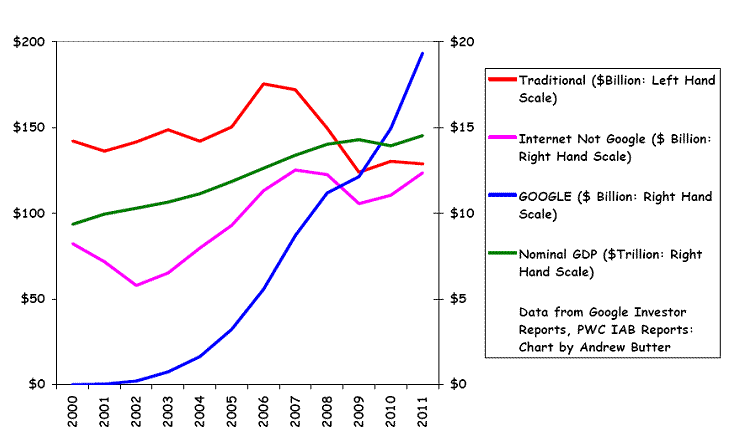
Notice how in the traditional market there was a bust caused by or in sympathy with the credit crunch and that affected “traditional” internet just the same (apart from Google).
The interesting thing there, by the way, is it looks suspiciously as if advertisers over-spent during the Golden Days of the housing bubble, or perhaps because of it, but now that the froth has disappeared (no one wants to advertise an apartment to flip in Las Vegas anymore), you have a typical bust following a period of what the Austrians call mal-investment
So….Phew!! All-Systems-Go, everything is perfectly normal so far, expect traditional advertising to start what that old fart Ludwig-the-Von called “the tedious process of recovery”…back to the long-term fundamental…any time soon, in fact it looks like internet (outside Google) already started that.
As for Google, well they are clearly on a roll. But it’s not obvious that they are taking very much market-share from the traditional or the internet sector.
What’s not shown on that chart, which is because I can’t get a timeline on the data, is the amount of advertising spent in “Directories” and “Direct Mail” which added together in 2006 generated $55.7 billion which was about 20% of total advertising spending, which was pegged by PWC at $285 billion back then (more than now).
I suspect that’s the main market that Google is eating into.
Remember leafing through Yellow Pages? Remember when, if you were an engineer you used to collect directories and dusty books with technical data you might need one-day, remember when you booked a flight or a hotel or a car by going to the travel agent and asking “what’s the best deal you can get me?” That’s all out window, now you just type something in Google, and even if you can’t spell, you have to be a complete moron not to get to what you want after three tries, maximum.
If you want to buy a lawnmower, you type in “lawnmower” (Duh), and pretty soon you have been bombarded with fifty advertisements on lawnmowers and you will know more about them than you could possibly have imagined, did you know some lawnmowers have slug catchers? Plus you have directions to the nearest ten retailers who stock them, along with a map and GPS coordinates.
Imagine how likely it would have been that a direct mail flyer about lawnmowers to have popped through your letter-box the day you finally decided to buy a new one, imagine if you got ten all on the same day?
So lets look at how that might stack up, given that Google appears to be big in the boring-old Directories and Direct Mail space, and Facebook is big in the “cool” space.
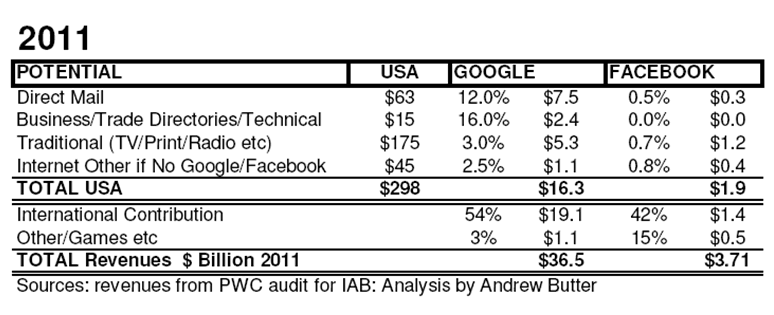
By the way, the total is more than my estimate of about $275 billion, because that’s “potential”, and as explained above, there is a bit of a cyclical slump going on right now, in any case, I’m talking rough numbers. My question is this, which part of that market segmentation matrix is Facebook proposing to grow market share, or in other words, which is the “cool” bit?
Remember, Google’s model delivers you the information, about lawnmowers for example, when you want it. Facebook only has the ability to deliver that information when the coolies (as opposed to the cool-people) figure you might want it, a bit like all those un-cool direct mail flyers you had to constantly throw away, before they invented Google:
Looking at the same thing from another angle, forget about how much profit Google was making when they went IPO, in start-ups it’s all about revenue, and the point at which your angels cashed out is irrelevant. Here’s the chart:
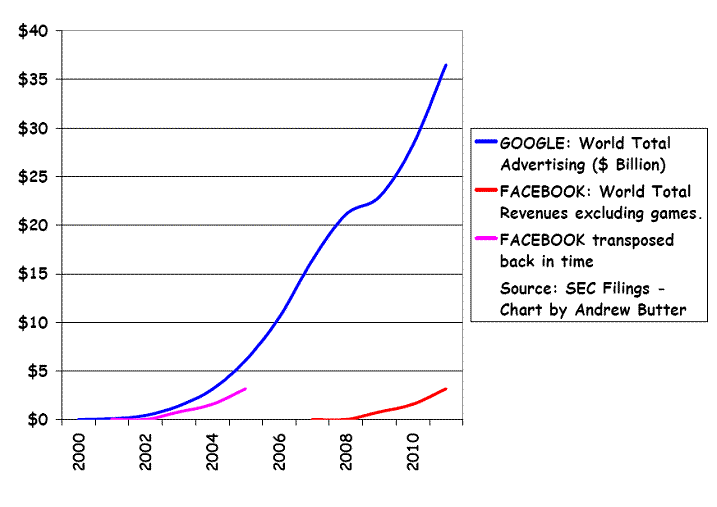
OK, you can argue about where the transposed line for Facebook starts in comparison to Google, but for me it starts when you lift off the floor, so my second point is that the way I look at it, Facebook is doing great, but not as great as Google did, and you have to remember I’m comparing 2005 dollars for Google with 2011 dollars for Facebook.
My third point is that as happens with most things, Google revenues went up in an “S” curve, it started slow as lift-off always does, then the low-hanging fruit got picked, and then what’s left is the ones you need a ladder to get to, so then growth started to slow down…in 2009… and then something happened, something new, and whoopee she is back galloping across the prairie like a mustang spooked by a rattler.
What happened is irrelevant, the point here is there was one “S” curve, then there was another; but we ARE talking “S” curves.
The thing about “S” Curves is they often follow the Normal Probability Function, so perhaps if we fit one of those to the first four points of Facebook’s revenues (including zero other thereabouts), we can predict the future?
I concede that drawing regression lines through four pieces of data and then projecting them outside the range of the data is the sort of thing that I used to get slapped on the side of my head for doing…with a ruler (the thin part too), and then I’d get told to stand in a corner until I almost peed my pants. So I ought to have learned my lesson, but just for fun…let’s be naughty, let’s break the rules, let’s be cool and have a look, I won’t tell if you don’t:
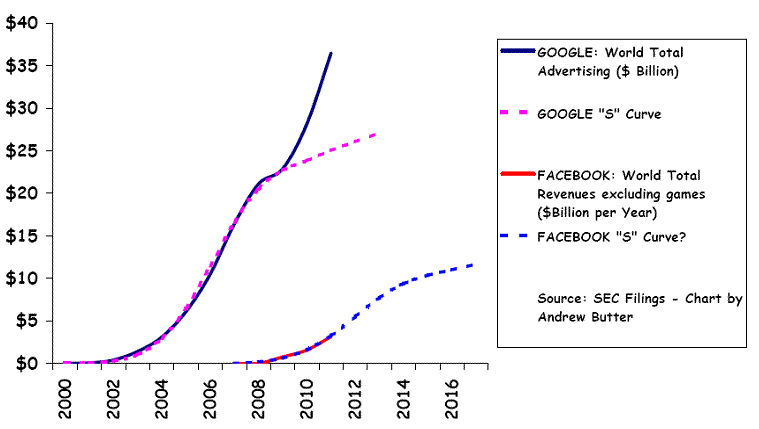
By the way, the R-Squared on those lines with ten points of data for Google (including zero and going up to where (I reckon) a new “S” curve started), and four points for Facebook, is 99%, which doesn’t say a lot since there isn’t enough data, but it does say something.
Sure, predicting the next ten years revenues for Facebook, from three years when they had revenues, is a bit of a stretch.
But Facebook isn’t offering any projections even though they got the Workers-Sent-By-God in their corner, in fact they aren’t even offering any explanation for how they will achieve the projections they are not telling us about…apart presumably from the information that the projection they made in 2010 for revenues in 2011 was 30% too optimistic, and Yahoo is suing their ass.
Here’s what I reckon is a reasonable projection for 2016:
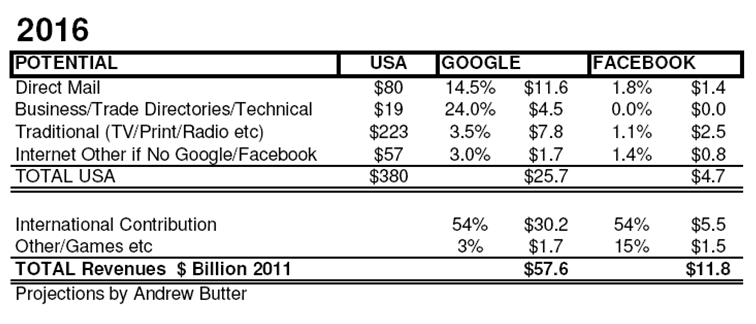
That’s another way of re-stating the 22-Imutable Laws of Marketing written all those years ago by Reis and Trout, who must both be really old and un-cool by now.
They said that when the market starts to mature #1 typically ends up with a much bigger share than #2, particularly when #2 doesn’t like the idea of being #2 and starts telling customers-off and reminding them he is one of the richest people in the world and so if they don’t like his bad-manners they call all go and F@#K themselves. I don’t know about ladies, but where I was brought up, that’s no way to talk to a customer.
The market cap of Pepsi Cola beverages is one third the size of the market cap of Coca Cola beverages. It’s always been like that, and it always will, cool-kids start off drinking Pepsi, then they grow up and they drink Coke, Coke got to the grown-ups first.
Oh you say, there are millions more potential friends!! Well, up to a point, in 2011 there were 2.45 billion internet users worldwide, now Facebook has 33% market share, but what they don’t tell you in the one piece of market information they provide in their filing to the SEC, is that the growth in market share is slowing…it’s reaching the end of its “S-Curve”, they told you how many users they had, but they didn’t say how much the number of internet users had gone up, plot that and you get to the dreaded droop!!
Put that another way, a big attraction of Facebook appears to be lonely people, perhaps the world is running out…as in “All the lonely people, where do they all come from?”
That was John Lennon by the way, now he was cool.
Facebook made no meaningful projections about market share, market segmentation, or revenues for the future in their SEC filing, here are mine:
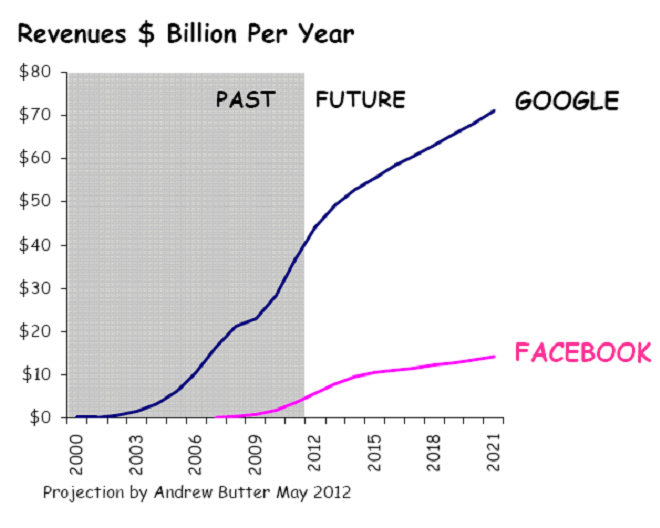
So what’s that worth, taking into account that the more you are uncertain about the future, the higher the discount factor you use in your calculation to work out the Net Present Value (NPV).
Right now Google’s market cap is $200 billion, assuming (for the sake of argument) net profit as a percentage of revenues for Facebook ends up pretty similar to Google, and assuming (lot of assumptions), that the market has priced Google correctly.
Then if you use the same inputs to discount forward cash flow that gets you to $200 billion on Google…on Facebook, you end up with a valuation, for today, of $38.2 billion.
But there again, Google is a known entity, for something that is a little bit better than a start-up with super-cool CEO, you increase the discount factor, by say 30% which gives a valuation of about $30 billion.
That’s my opinion. $35 a share gets you to about $100 billion market cap, $30 billion market cap gets you about $10 a share, and so if you are hoping your shares will do a Microsoft and double in the first year, my advice is don’t pay more than $5.
Unless of course Facebook has something else under it’s hoodie; that they aren’t telling us about?
By Andrew Butter
Twenty years doing market analysis and valuations for investors in the Middle East, USA, and Europe. Ex-Toxic-Asset assembly-line worker; lives in Dubai.
© 2012 Copyright Andrew Butter- All Rights Reserved
Disclaimer: The above is a matter of opinion provided for general information purposes only and is not intended as investment advice. Information and analysis above are derived from sources and utilising methods believed to be reliable, but we cannot accept responsibility for any losses you may incur as a result of this analysis. Individuals should consult with their personal financial advisors.
Andrew Butter Archive |
© 2005-2022 http://www.MarketOracle.co.uk - The Market Oracle is a FREE Daily Financial Markets Analysis & Forecasting online publication.



